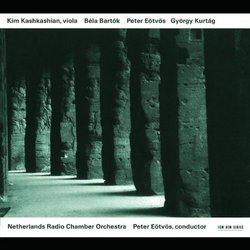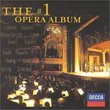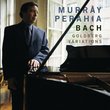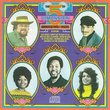| All Artists: Peter Eotvos, Gyorgy Kurtag, Kim Kashkashian, Netherlands Radio Chamber Orchestra Title: B�la Bart�k: Concerto for Viola & Orchestra / Peter E�tv�s: Replica / Gy�rgy Kurt�g: Movement for Viola & Orchestra - Kim Kashkashian Members Wishing: 2 Total Copies: 0 Label: Polygram Records Release Date: 6/13/2000 Genre: Classical Styles: Chamber Music, Forms & Genres, Concertos, Historical Periods, Classical (c.1770-1830), Instruments, Strings Number of Discs: 1 SwapaCD Credits: 1 UPC: 028946542026 |
Search - Peter Eotvos, Gyorgy Kurtag, Kim Kashkashian :: B�la Bart�k: Concerto for Viola & Orchestra / Peter E�tv�s: Replica / Gy�rgy Kurt�g: Movement for Viola & Orchestra - Kim Kashkashian
 | Peter Eotvos, Gyorgy Kurtag, Kim Kashkashian B�la Bart�k: Concerto for Viola & Orchestra / Peter E�tv�s: Replica / Gy�rgy Kurt�g: Movement for Viola & Orchestra - Kim Kashkashian Genre: Classical
Kim Kashkashian's interpretation of three Hungarian composers' works for viola is peerless. The viola is a perplexing, complex instrument that always seems out of time, almost out of place with the modern repertory. But th... more » |
Larger Image |
CD DetailsSynopsis
Amazon.com Kim Kashkashian's interpretation of three Hungarian composers' works for viola is peerless. The viola is a perplexing, complex instrument that always seems out of time, almost out of place with the modern repertory. But the melancholy and directness of the instrument, especially in the hands of such an accomplished performer as Kashkashian, make for a listening experience that is profoundly contemporary. Bartók's Concerto for Viola and Orchestra was one of the last pieces the composer wrote. In a sense unfinished, fragmentary (Paul Griffiths, in his liner notes, says the piece is "partial, imminent, not yet arrived"), the work is balanced by Eötvös's Replica, written especially for Kashkashian and recorded here for the first time. Kurtág's Movement, his graduation exercise presented to the Liszt Academy in Budapest in 1954, has a clear Bartókian hue, but also shows the influence of Brahms and Haydn. While it is a youthful work, it is no minor piece and, especially in the context of Kurtág's usual miniatures, is a fascinating listening experience. Eötvös shows himself to be a wonderful director, drawing from Kashkashian a precision and subtlety that the masculine viola sometimes lacks, while encouraging the Netherlands Radio Chamber Orchestra to support the fullest exploration of the pieces in hand. This is a remarkable, beautiful, and haunting recording. --Mark Thwaite Similarly Requested CDs
|
CD ReviewsKashkashian Conquers Hungary Marcus Maroney | New Haven, CT | 06/19/2000 (5 out of 5 stars) "Another fabulous disc from Kim Kashkashian, in Hungarian music for viola and orchestra. Kashkashian produces a dark, haunting tone that fits each work perfectly, and Peter Eotvos and the Dutch orchestra inhabit a complementary sound world, and the recording is up to the usual ECM standards (wide dynamic range, transparent orchestral texture, slight spotlight on the soloist). The Bartok concerto, admirably 'prepared' by Tibor Serly, is, in my opinion, the weakest on the disc. There are, as typical in Bartok, beautiful, rustic melodies in the same rhetoric as the 3rd piano concerto. This would have been an amazing piece had Bartok finished it. Serly did what he could, but we are still left with, as Paul Griffiths says in his excellent liner notes, "a world only partly defined." Eotvos' piece is very strong. The arrangement of the orchestra would perhaps be more apparante aurally in a live performance, but in certain instances (the last few minutes of the work, for example), the spatial ideas come across nicely. Overall, the work's sound world is very convincing , the orchestration unique and involving, and the performance riveting. The Kurtag work, from his student days (no date of composition is given in the liner notes) is very Bartokian, and, having listened to it first before reading the liner notes, I was worried that this master composer had suffered from a severe bout of Pendereckitis (reverting to conservative, proto-Brahms modernism). The piece definitely contrasts all other Kurtag that I know (the song cycles, double concerto, Jatekok, etc), and is on a much larger scale than all those. A 12 minute work now would be a 'grand gesture' from this miniaturist, but with such lyrical melodies and more traditional harmonic language, the material fills the form to a T, and the overall shape of the work is gorgeous. The long lines for the solo viola are tastefully shaped by Kashkashian, and the accompaniment (and the orchestra does provide, for the most part, just that) is wonderfully shaded. Overall, an excellent disc." Just Amazing! Jon Byrne | Manchester, New Hampshire United States | 02/27/2004 (5 out of 5 stars) "Kim Kashkashian's recording of the Bartok Viola Concerto is the best I have heard. It helped me when getting a sense of the piece before I started working on it. The Replica, and The Movement for Viola and Orchestra where two piece I had never heard of before now I enjoy them, and can't wait to play them!!!-Jon" You can never argue with great playing, scarecrow | Chicago, Illinois United States | 06/30/2007 (5 out of 5 stars) "The references here(other reviewers) to minor works, minor as compared to what or who?? The opaque Question,the Big Unknown.
This is all great music,(even though I disliked marginally the Kurtag). All the music here sensitively played and interpreted with imagination. With Peter Eotvos you have one of the most gifted(aggressive) musical visions,technicians, a man of passion as well. All the categories for egocentric analysis is here clarity,relevance,precision, depth; the ensemble balance he brings from the Netherlands Radio Orchestra is astounding. We merely think this level of interpretation is a norm now these performances,with students of Pierre Boulez (as Eotvos) but Eotvos,recall; all the experience he has under-his-belt now with contemporary repertoire.He lends another vision to the Bartok,one I had not heard. He scales down the obvious,the folk gestures are subdued in place of the fascination with the timbre of the work, the modernity of the score is affirmed. The Viola is unencumbered throughout,and I suspect the incompletedness of the work gave it more clarity,and more modern interest,so it is sketchlike,perhpas unfinsished ideas not allowed to develop; let's not be naive, Bartok had good days and bad, and he was losing creative focus in his latter concerti, like the "Third Piano Concerto" is a waste of time.Now living in poverty outside New York City in an old wooden shak,he was demorilized. I suspect all serious Violists marvel at the fact that they have this work, It is a high point in the literature.In Searly's completion,you barely suspect any dramatic differences,or how the work should have been, could have been, Bartok's aesthetic is fairly predictable, he had his creative "comfort zones" that he frequently visited. We all know the aesthetic strategies at work ad infinitum, ad nauseaum at times. The star Violist here Kim Kashkashian equals Eotvos in vision and clarity. She never allows the obvious gestures of the score to take hold of the discourse of the music, and her vision remains firm well into the piece.She plays on the darker side, the Violoncello side of the viola timbre, something I prefer, you may not. This richness is captivating,it has a longevity; you can listen for hours to this tone. The Eotvos "Replica" is a fairly interesting piece. We really cannot get hold of his creativity;if you have followed his career, Eotvos many times looses focus.Perhaps the life of writing strictly under commission sets this "factory" quality to works,"works on demand", and "ordered" music for occasions. He was quite devoted to the popular strains in the avant-garde,with electronics as his fascinating and powerful "Chinese Opera" and "Intervalles. . ". But his Hungarian,pre-IRCAM experiences in jazz and writings countless filmscores reveals his DNA in music should we say. Eotvos is direct,sometimes uninterestingly so; he has an affinity and a nurturing quality to communicate by any means necessary, and his music is best when direct as here, the overwhelming warm lyricism,in "Replica"(materials from his successful opera :Three Sisters: you can warm your hands to it, like by a roaring log cabin fire.There are modern timbres here, the high pencil-thin harmonics reminds one of electronic timbres,cold abstracted, frozen. The orchestral moments simply embellish, and punctuate the viola, adding no real materials of their own, more like mists, setting the contexts, for the Viola to proclaim its anxiety ridden questions. There are darknesses here,perhaps the rustic life,the basics, the peasnat ways and lifeworlds informs all of this music. Less so the Kurtag, this is not too interesting Kurtag. His orchestrations are hit-or-miss. He has better vision for smaller situations and musical structures, as his string quartet music,"The 12 Microludes" or his vocal music, and chamber settings with mixed instruments. He lets his imagination find new contexts, and places few would go.Like his pieces using single and mixed solo-like gestures, and voice. Here in "Movement", the Viola struggles unconvincingly; to me anyway. You may find the affair fascinating.But Kurtag likes the soloists the role to comment, and with gestiral digressions from the solo materials,the solo voice.There is also an uninteresting neo-romantic strain here, and you need to know your materials when you venture into utilization of these well-trodden accessible lifeworlds. Penderecki,Dusapin and Rihm know this route, this well-known trajectory of the common, and knows its dangers. Kurtag writes as if the avant-garde never happened,rather than being informed by it; cloistered in the woods,looking at those "comfort zones" of times gone, never to return. Leave the 19th century alone, it has produced what we all have lived by,no need to return. So the musical structures can become off-balanced forsaking the overall drama of the work. He then thinks he needs to refill-re-populate these dramatic sections with large loud moments somewhat arbitrary in placement; to encompass or overwhelm the poor solo Viola. The Viola yes is reduced to single plaintive tremoli, as if its voice is reduced, now dilute, shell-shocked from violence. The length of Eleven minutes Fifty-three Seconds seem much longer than this. some editing should have been put eraser to music, as Stravinsky said, music is really written "aven le gum". The orchestration is then really not all that interesting, this from a composer who is known for his trimbral sensitivity. The timbres here seem one-dimensional large. But there is heartfelt play in the Viola, it trys to re-assert itself against the seeming "tyranny" of the orchestra. Kurtag is moving when he evokes the intimate, the introspective elements, the deeply subjective, and here this comes in the final moments of the work. Perhaps the context is well worth the time expended." |

 Track Listings (5) - Disc #1
Track Listings (5) - Disc #1








